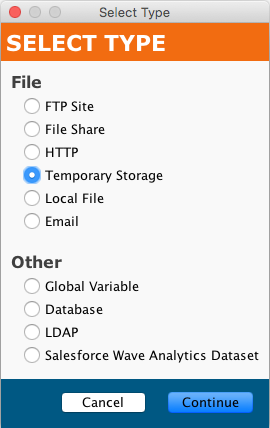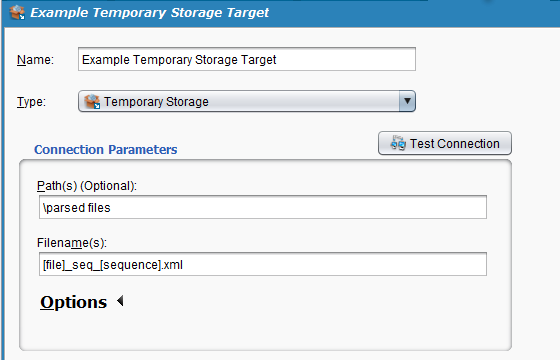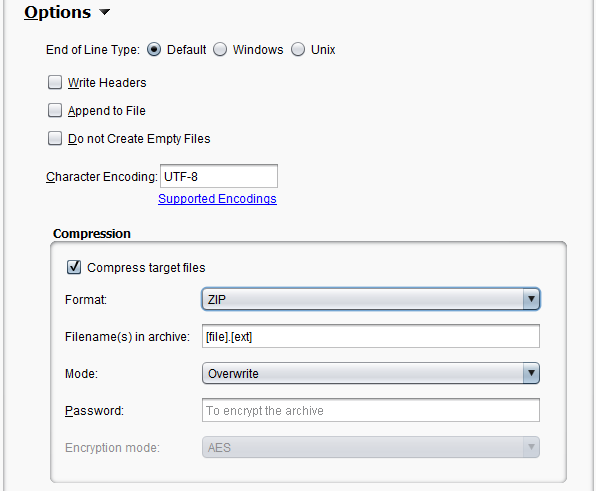Create a Temporary Storage target in Jitterbit Design Studio
Introduction
Temporary Storage is a built-in location, such as a target, that can be used as a temporary repository of files. A temporary storage location is referenced by a path which points to a folder in a temporary directory on the private agent or cloud agent.
For details on where files and folders are located and the considerations when using Temporary Storage, see Temporary Storage.
Create a Temporary Storage target
You can choose to create a new Temporary Storage target on its own, or within an existing operation. For more information on how targets work within operations, see Creating an operation.
Create a new Temporary Storage target as a standalone target
Within your project in Jitterbit Design Studio, you create a new Temporary Storage target by any of:
-
eGo to File > New > New Target; or
-
In the tree on the left, right-click on Targets and select New Target; or
-
In the top toolbar, click the blue target icon
 .
.
In the popup, select Temporary Storage as the type:

Your new target appears in its own New Target tab in the right pane of the window.
Note
If you create a standalone target using any of these methods, note that it is not connected to an operation. See Use an existing Temporary Storage target in an existing operation below to use the new target.
Create a new Temporary Storage target in an existing operation
A target is usually created by default when you create a new operation. (The exception is an operation that consists only of a script.) With an existing operation, you can specify the type of its target by:
-
Double-clicking on the target icon; in the popup, select Create New Target; or
-
Right-clicking on the target icon and selecting Create New Target.
In the configuration screen that appears, use the Type dropdown to select Temporary Storage, as shown above.
Use an existing Temporary Storage target in an existing operation
To use an existing Temporary Storage target in an existing operation with a target, you can set it by any of:
-
Within the operation, double-clicking on the target icon, and in the resulting popup, selecting the desired Temporary Storage target from the list; or
-
Within the operation, right-clicking on the target icon, choosing Select Existing Target, and in the resulting popup, selecting the desired Temporary Storage target from the list; or
-
Dragging the desired Temporary Storage target from the tree on the left and dropping it onto the existing target icon of the operation.
Configure a Temporary Storage target
After you have created a Temporary Storage target, the configuration screen will open in the main view of Design Studio. You can return to the configuration screen at any time by double-clicking on the target icon in the operation, or by double-clicking on the target in the tree on the left.
Basic configuration
The configuration screen will appear similar to this example:

- Name: Enter an appropriate, unique name for the target.
- Type: Use the dropdown to select Temporary Storage, if it is not already specified.
-
Connection Parameters: Specify the details for your temporary storage connection:
-
Path(s) (Optional): Enter a string in the Path(s) field.
- Characters that cannot be used in a file name (such as
*, ?, <) are not allowed. Either'/'or'\'can be used as path separators. - Multiple paths can be specified using comma-delimited values. If multiple paths are specified, the same file is written to multiple locations.
- These paths are to be directories on the machines where the agent is installed.
- This field is optional; if specified, it should be a path that will be globally unique, as any user of the same agent can read or write files to temporary storage.
- Characters that cannot be used in a file name (such as
-
Filename(s): Enter the desired name for the target file(s). Wildcards and variables may be used in this field. If specifying a compressed file (ZIP), see the "Compression" section of the additional connection parameters under Options below. The file will automatically be written into the archive at the root level.
-
-
Test Connection: Clicking the
 button will test the Temporary Storage target; it will fail if the path is not a valid file name on the operating system where the Jitterbit agent is running. It does not test if the specified user has write permission on the directory.
button will test the Temporary Storage target; it will fail if the path is not a valid file name on the operating system where the Jitterbit agent is running. It does not test if the specified user has write permission on the directory. -
Click the Save button in either the main toolbar or the target's toolbar to save the configuration.
Options
Additional connection parameters can be specified by clicking the Options at the bottom of the Connection Parameters section:

-
End of Line Type: Determines how Jitterbit writes line breaks when writing to a target. Note that end-of-line characters in the data will not be converted. Available options:
- Default: Standard end-of-line characters for the platform the agent is running on.
- Windows: CRLF (ASCII 13 and ASCII 10)
- Unix: LF (ASCII 10)
-
Write Headers: If checked and a flat text target, a header of column/field names will be written as the first line.
- Append to File: If checked, data will be appended to an existing target file instead of overwriting.
- Do not Create Empty Files: If checked, creating the target file will be skipped if there is no target data.
- Character Encoding: Used to specify a character encoding for the target file. If left blank, Jitterbit will attempt to detect the encoding. To specify a different encoding than that default, insert one of the supported encodings described in Supported character encodings.
-
Compression: If the checkbox for Compress target files is selected, target files will be compressed using the ZIP format. Additional options are:
- Filename(s) in archive: Accepts variables and filename keywords. To keep the filename in the archive the same as the filename defined in the target, use a format of
[file].[ext]as shown above. - Mode: One of Overwrite or Append. Overwrite will overwrite an existing archive. For non-encrypted archives, Append will add files to an existing archive. This mode is only available for Temporary Storage (and Local File) targets.
- Password: For encrypted archives, supply a password.
- Encryption mode: If a password is supplied, two encryption are modes available: AES or Standard ZIP.
- Filename(s) in archive: Accepts variables and filename keywords. To keep the filename in the archive the same as the filename defined in the target, use a format of